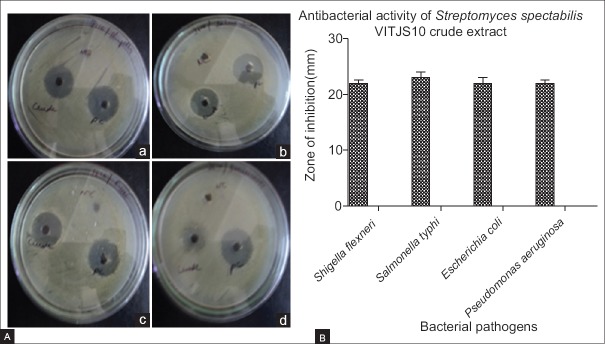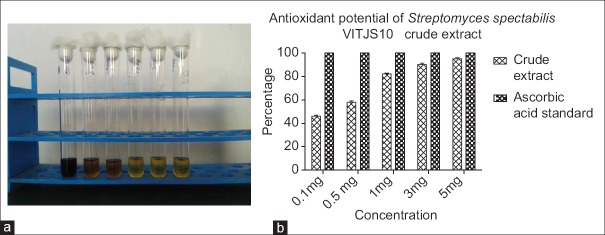Abstract
Background:
Recently, numerous pathogens have developed resistance due to the indiscriminate use of commercial therapeutic drugs.
Objective:
The main aim of the study was to evaluate the bioactive potential of the Streptomyces spectabilis VITJS10 crude extract.
Materials and Methods:
The S. spectabilis VITJS10 ethyl acetate extract was tested for antibacterial, antioxidant, and cytotoxic properties. Genotypic characterization was done using 16S r-DNA partial gene amplification and sequencing. The authenticity of the crude chemical constitutes were determined by gas chromatography–mass spectrometry (GC-MS).
Results:
The antibacterial potential revealed the effective activity against Shigellaflexneri (MTCC No: 1457) (22 mm), Salmonella typhi (MTCC No: 1167) (23 mm), Escherichia coli (MTCC No: 1588) (22 mm), Pseudomonas aeruginosa (MTCC No: 4676) (22 mm) at 20 mg/mL concentration. Scavenging ability of the extract was determined using 2,2-diphenyl-1-picrylhydrazyl (DPPH) assay revealing its 95% inhibition at 5 mg/mL concentration. Hepatocellular cancer cells (HepG2) cell line was used to evaluate the cytotoxicity by 3-(4, 5-dimethyl thiazol-2yl)-2, 5-diphenyl tetrazolium bromide assay. The extract showed maximum inhibition at IC50 of 250 μg/mL with 53.6% cell viability. The highest 16S rRNA gene sequence homogeneity was observed 99% similar with the novel strain S. spectabilis S3-1. The chemical components of the crude extract of VITJS10 were detected with 37 chemical constituents. However three major compounds were identified, namely Sulfurous acid, 2-ethylhexyl tridecyl ester, Phenol, 2,4-bis (1,1-dimethylethyl), and Trans-2-methyl-4-n-pentylthiane, S, S-Dioxide.
Conclusion:
Hence the present study justifies the overwhelming circumstantial evidence as the most bioactive metabolites from the marine origin, which has potential utilization in pharmaceutical industry.
SUMMARY
The aim of this study was to explore the bioactive potential of marine Streptomyces sp. isolated from marine soil and understand the bioactive properties of the crude extracts. It is clearly evident from the study that the bioactive metabolites produced by Streptomyces sp. exhibited good antibacterial, antioxidant and anticancer activity. Our results indicated that Starch casein medium was the good base for bioactive metabolite production. The taxonomic position of Streptomyces sp. isolated revealed unique pattern of phenotypic properties that distinguished it from representatives. The molecular characterization results provided valuable data for establishing the internal taxonomic structure of the genus. Hence high mortality rates, serious side effects, deficiencies of the available chemotherapeutics, and high costs during treatment clearly underscore the need to develop new anticancer agents, With the above significant features the strain could be recommended for its use in medicinal and agricultural sectors, an extensive knowledge on the behavior of natural compounds can be gained for the benefit of health.
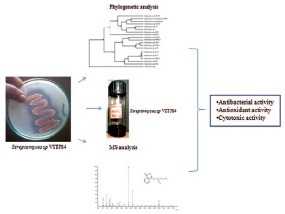
Keywords: Bioactivity, cytotoxicity, MARINE actinomycetes, secondary metabolites, Streptomyces spectabilis, VITJS10
INTRODUCTION
Cancer is a leading cause of death worldwide, accounting for approximately 1/8 of all deaths.[1] Moreover, antimicrobial resistance causes more extensive morbidity and premature death in infected patients. There is certainly an urgent need for new antimicrobial agents, given the increase in drug resistance in many common bacterial pathogens and changes in the spectrum of pathogens. Research strategies for the discovery of new antimicrobial drugs are heavily influenced by the need to discover and develop new agents active against organisms resistant to earlier generations of drugs. Anticancer drugs from marine origin have received much attention in recent years. It is increasingly evident that the true biological origin of many metabolites originally isolated from certain marine microorganisms. Secondary metabolites from marine actinomycetes have been extensively reviewed recently, demonstrating their structural diversity and emphasizing their promising potential as pharmaceuticals and to enable enhanced detection of novel chemical class of antibiotics. The discovery of new active metabolites must be followed by adequate biological testing.[2] Hence the present study was focused to characterize the Streptomyces spectabilis VITJS10 crude extract for its biological potential.
MATERIALS AND METHODS
Sample collection, isolation, and characterization of marine actinomycetes
Marine soil samples were collected from south-east coast of Tamil Nadu, India, Kanyakumari – Chinnamuttom (Lat. 8°5”N and 77°39’E), at the depth of 50 cm at littoral zone. The isolation of Actinobacteria was performed on starch casein agar. The morphological and cultural characteristics of the potent strain were determined on various ISP medium.[3] The spore morphology was observed under a light microscope and scanning electron microscopy (SEM) (FEI QUANTA; FEG 200). The morphological identification was done on the basis of nonomura guidelines.[4,5]
Cross streak assay
The strain Streptomyces sp VITJS10 was cross streaked on modified nutrient glucose agar against wide range of clinical pathogens namely Shigella flexneri (microbial type culture collection and Gene Bank [MTCC] No: 1457), Salmonella typhi (MTCC No: 1167), Escherichia coli (MTCC No: 1588), Staphylococcus aureus (MTCC No: 7405), and the zone of inhibition was measured after 2 days of incubation.[6]
Production
The inoculum of the potent strain Streptomyces sp VITJS10 was prepared on starch casein broth at an incubation period of 7 days at room temperature. Simultaneously the culture filtrate was extracted with ethyl acetate and concentrated by using a rotary evaporator.[7] The extract was then air dried to solid residue and tested for bioactive potential.
Antibacterial activity
The in vitro antibacterial activity of the strain Streptomyces sp VITJS10 crude extract was determined by agar well diffusion method.[8]
Antioxidant activity
The antioxidant activity was determined by 2,2-Diphenyl-1-picrylhydrazyl (DPPH) scavenging assay. Various concentrations (0.1, 0.5, 1.0, 3.0, and 5.0 mg/mL) of Streptomyces sp VITJS10 crude extract was taken in separate tubes. Ascorbic acid was used as reference compound (0.1, 0.5, 1.0, 3.0, and 5.0 mg/mL). A freshly prepared solution of 0.002% DPPH in methanol was added to each tube containing different concentrations of extracts (2.0 mL). The samples were incubated in dark at 37°C for 20 min and read at 515 nm. The data was expressed as the percent decrease in the absorbance compared with the control. The percentage inhibition of radical scavenging activity was calculated.[9]
Maintenance of cell cultures
The hepatocellular cancer cells (HepG2) were obtained from NCSS, Pune and cultured in RPMI-1640 medium on 10 cm tissue culture dishes (Greiner Bio-one™, Germany) supplemented with 10% heat inactivated fetal bovine serum (FBS). Cells were incubated in humidified incubator with 5% CO2 at 37°C, and sub-cultured when confluence was reached up to 80%.[10]
Cytotoxic assay
The 3-(4, 5-dimethylthiazol-2-yl)-2-5-diphenyl tetrazolium bromide (MTT) assay was used to assess the viability of the cells. The HepG2 cells (5 × 103) were seeded per well into 96-well plates containing 100 µL Dulbecco's Modified Eagle medium with 10% FBS incubated at 37°C for 24 h, Then, the cells were treated with 100 µL of the of Streptomyces sp VITJS10 crude extract in triplicates with different concentrations ranging from 1 to 500 μg/mL. Doxorubicin (5 µg/mL) was used as internal positive control and 100 µL of DMEM was used as negative control; wells without any cells were considered as blank. After incubating in humidified incubator with 5% CO2 at 37°C for 48 h, 20 µL of 5 mg/mL MTT diluted in phosphate-buffered saline (PBS) were added to each well and incubated for 4 h. One hundred microliter of 10% Sodium dodecyl sulfate (SDS) in 0.01 M Hydrochloric acid solution was added to each well to dissolve the formazan crystals formed. The plates were covered with aluminum foil and kept in an incubator for 12 h for dissolution of the formed formazan crystals. Amount of formazan was determined measuring the absorbance at 560 nm using a micro plate reader.[11]
16S r DNA sequencing
Total genomic DNA was isolated using the phenol chloroform method.[12] Polymerase chain reaction (PCR) amplification of 16S r-DNA was carried out using the primers. Sequencing was performed using big dye terminator cycle sequencing kit (Applied BioSystems, USA). The sequence data was submitted to the GenBank database under the accession number KJ636987. The phylogenetic tree was constructed via the neighbor-joining method using the EvolView program.[13]
Gas chromatography–mass spectrometry analysis
The crude extract of Streptomyces sp VITJS10 was subjected to gas chromatography–mass spectrometry (GC-MS) for the detection of volatile compounds. The analysis was performed using GC SHIMADZU QP2010 system.[14] NIST08 and WILEY8 database was used for the identification of the separated peaks. The diversity of compounds was indicated by the metabolite profiles.
RESULTS
Marine actionomycetes are the richest source of bioactive compounds used in modern medicine as pharmaceutical intermediates. Microbial derived metabolites have recently attracted great interest, owing to their versatile applications. The strain VITJS10 was studied on the basis of its morphology and recognized by their presence of aerial hyphae with reddish orange color [Table 1]. The colonies with powdery appearance had a characteristic feature of warty surface with spiral chains under SEM (magnification 6000×) with spore diameter of 0.6 µm [Figure 1a and b]. The biochemical and taxonomical characterization represented the features of Streptomycetaceae family. The antibacterial activity was screened and confirmed through cross streak assay against the pathogens showing broad spectrum [Figure 2]. The ethyl acetate extract showed broad spectrum antimicrobial activity toward Gram-positive and -negative bacteria at the concentration of 20 mg/well against S. flexneri MTCC No: (1457) (22 mm), S. typhi MTCC No: 1167 (23 mm), E. coli MTCC No: 1588 (22 mm), Pseudomonas aeruginosa MTCC No: 4676 (22 mm) [Figure 3A and B]. The crude extract studied for its antioxidant activity at different concentrations displayed highest degree at 5 mg/mL with 95% inhibition [Figure 4a and b]. The hemolytic property of the S. spectabilis VITJS10 crude extracts revealed maximum zone of lysis with 15 mm. The S. spectabilis VITJS10 crude extracts was also found to exhibit significant anticancer activity against HepG2 with the inhibition rate of 53.6% at concentration of 250 µg/mL. The positive control doxorubicin (5 µg/mL), which was used as internal positive control, showed 94% cell lysis at concentration of 250 µg/mL. The HepG2 cells was noticed with highest percentage of cell death [Figure 5]. The 16S rDNA sequence revealed the highest similarity to S. spectabilis S3-1 with 99%. Further the isolate VITJS10 was named as Streptomyces spectabilis VITJS10 [Figure 6]. The chemical constitutes of S. spectabilis VITJS10 crude extract revealed 37 chemical compounds; out of which, 3 important components were identified. The major chemical structures namely Sulfurous Acid, 2-ethylhexyl tridecyl ester were noticed with the retention time (RT) at 6.16 min showing peak at m/z 376 [M] + in accord with the molecular formula, C21H44O3S. Phenol, 2,4-bis (1,1-dimethylethyl) (MW-206) Formula- C14H22O, which showed its RT at 13.20 min, Trans-2-methyl-4-n-pentylthiane, S, S-Dioxide, RT at 14.1 min: (MW218) C11H22O2S [Figure 7]. The study justifies that marine Streptomyces provide a number of metabolites when compared with other bacteria. Hence the study showed significance results as promising targets for the development of cytotoxic and antimicrobial drugs.
Table 1.
Streptomyces spectabilis VITJS10: Morphological, physiological, and biochemical properties
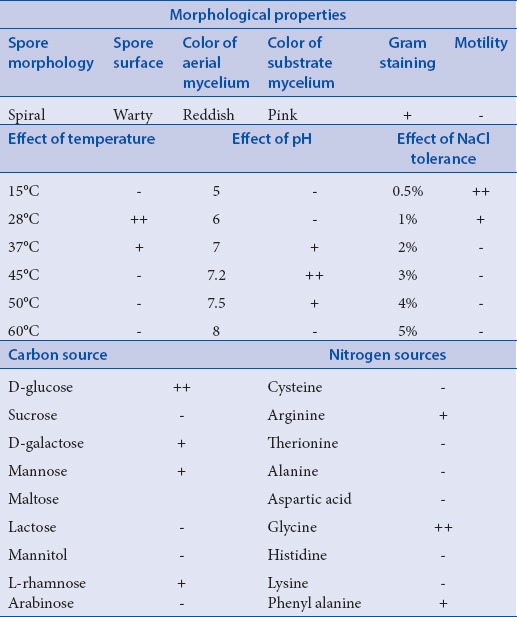
Figure 1.
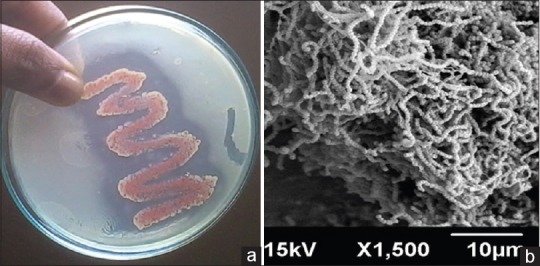
(a) Streptomyces spectabilis VITJS10 on starch casein agar; (b) scanning electron microscopy analysis of Streptomyces spectabilis VITJS10 spores
Figure 2.
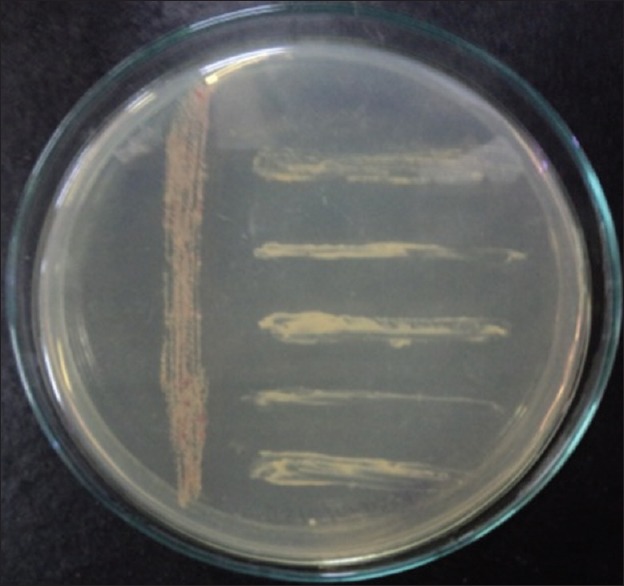
Cross streak assay of Streptomyces spectabilis VITJS10
Figure 3.
(A) Pictorial view showing the inhibition of bacterial pathogens (a) Shigella flexneri MTCC No: (1457), (b) Salmonella typhi MTCC No: 1167, (c) Escherichia coli MTCC No: 1588, (d) Pseudomonas aeruginosa MTCC No: 4676. (B) Graphical representation of antibacterial property Streptomyces spectabilis VITJS10 crude extract
Figure 4.
(a) Pictorial view showing antioxidant property of Streptomyces spectabilis VITJS10 crude extract (b) Graphical representation of antioxidant property of Streptomyces spectabilis VITJS10 crude extract
Figure 5.
(a) Percentage of cell viability shows the effective drug concentration toxic to HepG2 cell lines. (b) Morphological changes in HepG2 cell lines after treated with standard drug (Doxorubicin) and crude extract of Streptomyces spectabilis VITJS10
Figure 6.
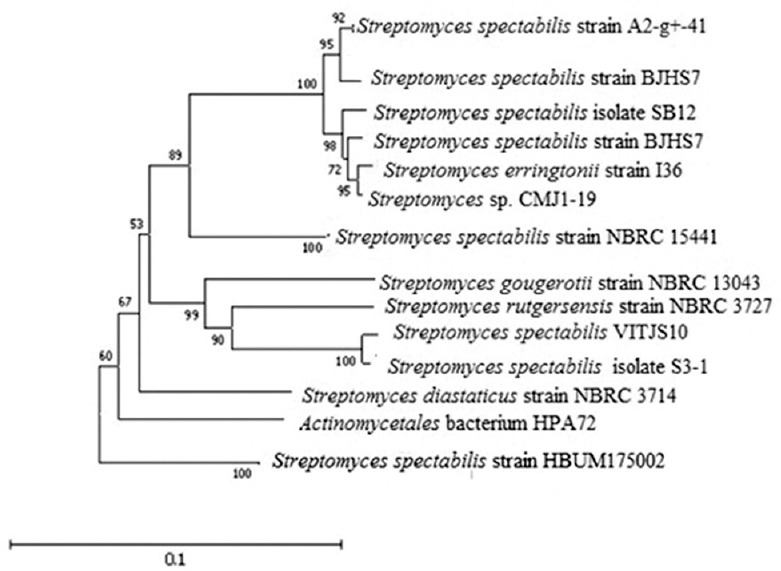
Phylogenetic tree of Streptomyces spectabilis VITJS10
Figure 7.
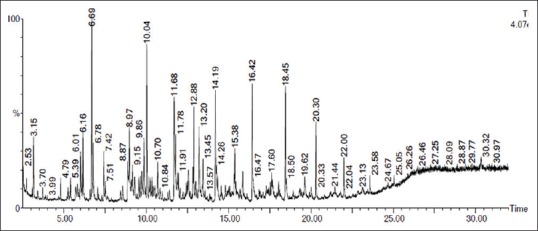
Gas chromatography–mass spectrometry chromatogram of Streptomyces spectabilis VITJS10 crude extract
DISCUSSION
Recently, much attention has been directed toward biologically active compounds isolated from marine saltern. The natural products have been shown to have antioxidant activity and are capable of scavenging free superoxide radicals, thus reducing the risk of cancer.[15] One of the more significant findings emerge from this study is that the S. spectabilis VITJS10 extract exhibited a promising anticancer activity on human liver cancer cell lines. Several mechanisms were found to underlie these multifaceted synergistic activities of the active principles. The potential of antimicrobial and anticancer activity perhaps would be due to the presence of the parental compounds in the crude extract showing distinctly synergistic effects. Similarly, most of the bioactive molecules isolated from Actinobacteria are cytotoxic: Streptazone B1produced by strains HB117, HB122, and HB291.[16] Fredericamycin A (produced by strains HB116, HB118, and HB157).[17] The present study has shown the beneficial effects of the S. spectabilis VITJS10 synergistic compounds. Further studies are needed to confirm in large, rigorous trials. Hence the advantages of natural compounds are known with fewer side effects in comparison to orthodox medical drugs, which indicate more specific for the positive treatment outcome.
CONCLUSION
Streptomyces spectabilis VITJS10 showed various bioactive properties, which highlighted its importance as potential pharmacological agents. Hence, there could be probability of new bioactive compound in the crude extract, which might provide a basis for further development of novel compound. This also provided a new insight toward the development of good candidates for pharmaceutical and bioactive natural products.
Financial support and sponsorship
The authors are greatly indebted to Vellore Institute of Technology for the constant encouragement, help, and support for extending necessary facilities.
Conflicts of interest
There are no conflicts of interest.
ABOUT AUTHORS

Dr. Jemimah Naine
Dr.Jemimah Naine is currently working as Research associate at VIT University. Her research is inspired by naturally occurring antibiotics and anti-tumor compounds as well focused on molecular mechanisms involved in drug resistance of cancer.

Dr. C. Subathra Devi
Dr. C. Subathra Devi is an Assistant professor (Senior) at the Industrial Biotechnology Division, VIT University. She is expertise in industrial enzymes and proteins. Currently her team is working especially on clot buster enzymes and anti-cancer agents from marine actinomycetes.
Acknowledgments
The authors are greatly indebted to Vellore Institute of Technology for the constant encouragement, help, and support for extending necessary facilities.
REFERENCES
- 1.Jemal A, Bray F, Center MM, Ferlay J, Ward E, Forman D. Global cancer statistics. CA Cancer J Clin. 2011;61:69–90. doi: 10.3322/caac.20107. [DOI] [PubMed] [Google Scholar]
- 2.Jemimah NS, Vaishnavi B, Mohanasrinivasan V, Subathra Devi C. Screening for anti-microbial and anti-oxidant property of Streptomyces sp. VITJS3 isolated from Bay of Bengal, Puducherry coast of India. J Pure Appl Microbiol. 2014;8:1125–32. [Google Scholar]
- 3.Nonomura H. Key for classification and identification of 458 species of the Streptomycetes included in ISP. J Ferment Technol. 1974;52:78–92. [Google Scholar]
- 4.Brock TD, Madigan MT, Martiko JM, Parker J. Biology of Microorganisms. 7th ed. Englewood Cliffs: Prentice Hall, International Inc; 1994. [Google Scholar]
- 5.Prescott SC, Dunn GG. Industrial Microbiology. 3rd ed. New York: McGraw-Hill; 1959. pp. 762–835. [Google Scholar]
- 6.Remya M, Vijayakumar R. Isolation and characterization of marine antagonistic actinomycetes from west coast of India. Med Biol. 2007;5:13–9. [Google Scholar]
- 7.Pandey B, Ghimire P, Agrawal VP. Kathmandu, Nepal: PhD Dissertation, Tribhuvan University; 2004. Studies on the Anti-microbial Activity of Actinomycetes Isolated from Khumbu Region of Nepal. [Google Scholar]
- 8.Osawa T, Yoshida A, Kawakishi S, Yamashita K, Ochi H. Protective role of dietary anti-oxidants in oxidative stress. In: Cutler RG, Packer L, Bertram J, Mori A, editors. Oxidative Stress and Aging. Switzerland: Birkhauser Verlag, Base; 1995. pp. 367–77. [Google Scholar]
- 9.Jemimahnaine S, Subathra Devi C, Mohanasrinivasan V, Vaishnavi B. Bioactive potential of astrain Streptomyces sp. VITJS11 isolated from marine sediments. Braz Arch Biol Technol. 2015;58:198–207. [Google Scholar]
- 10.Freshney RI, Hart E, Russell JM. Isolation and purification of cell cultures from human tumours. In: Reid E, Cook GM, Moore DJ, editors. Cancer Cell Organelles; Methodological Surveys (B): Biochemistry. Vol. 2. Chicester, UK: Horwood; 1982. pp. 97–110. [Google Scholar]
- 11.Mosmann T. Rapid colorimetric assay for cellular growth and survival: Application to proliferation and cytotoxicity assays. J Immunol Methods. 1983;65:55–63. doi: 10.1016/0022-1759(83)90303-4. [DOI] [PubMed] [Google Scholar]
- 12.Rainey FA, Ward-Rainey N, Kroppenstedt RM, Stackebrandt E. The genus Nocardiopsis represents a phylogenetically coherent taxon and a distinct actinomycete lineage: Proposal of Nocardiopsaceae fam. nov. Int J Syst Bacteriol. 1996;46:1088–92. doi: 10.1099/00207713-46-4-1088. [DOI] [PubMed] [Google Scholar]
- 13.Benson DA, Boguski MS, Lipman DJ, Ostell J, Ouellette BF, Rapp BA, et al. GenBank. Nucleic Acids Res. 1999;27:12–7. doi: 10.1093/nar/27.1.12. [DOI] [PMC free article] [PubMed] [Google Scholar]
- 14.Jemimah NS, Nasimunislam N, Vaishnavi B, Mohanasrinivasan V, Subathra Devi C. Isolation of soil actinomycetes inhabiting Amirithi forest for the potential source of bioactive compounds. Asian J Pharm Clin Res. 2013;5:189–92. [Google Scholar]
- 15.Park SJ, Myoung H, Kim YY, Paeng JY, Park JW, Kim MJ, et al. Anti-cancer effects of genistein, green tea catechins, and cordycepin on oral squamous cell carcinoma. J Oral Maxillofac Surg. 2008;34:1–10. [Google Scholar]
- 16.Puder C, Krastel P, Zeeck A. Streptazones A, B (1), B (2), C, and D: New piperidine alkaloids from streptomycetes. J Nat Prod. 2000;63:1258–60. doi: 10.1021/np0001373. [DOI] [PubMed] [Google Scholar]
- 17.Warnick-Pickle DJ, Byrne KM, Pandey RC, White RJ. Fredericamycin A, a new antitumor antibiotic. II. Biological properties. J Antibiot (Tokyo) 1981;34:1402–7. doi: 10.7164/antibiotics.34.1402. [DOI] [PubMed] [Google Scholar]



